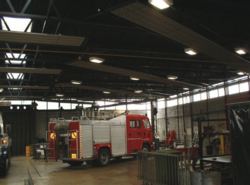Re-assessing the true cost of lighting

It is estimated that the very long-life — about 19 years — of Chalmor Endurance lighting fittings will save over £20 000 on maintenance costs alone for this installation at the Fire Service College.
Life-cycle costing is an important element in value-engineering exercises that seek to minimise whole-life costs. STEVEN HENRY suggests that life-cycle-costing exercises for lighting are becoming increasingly complex.Value engineering, in its truest sense of the phrase, is about giving the end user the best value from their building-services plant throughout its life. To achieve this, therefore, it is necessary to calculate the whole-life-costs of the installation rather than just the capital costs.
Changes in legislation In the case of lighting, life-cycle costing used to focus simply on the cost of buying, installing and maintaining the luminaires and associated controls — as well as the energy costs through the life of the installation. Thanks to recent changes in legislation there are now additional considerations relating to disposal of lamps at the end of their life. With the greater emphasis on energy efficiency we have seen in recent years, there is now much wider use of discharge light sources such as fluorescent, metal halide, sodium and mercury vapour. While these lamps make a positive contribution to energy efficiency, they also present additional environmental challenges which have a direct bearing on the life-cycle cost of lighting. This is because discharge lamps contain small amounts of mercury, so that disposing of high volumes of discharge lamps to the normal waste stream has the potential to cause considerable environmental damage. As a result, recent and imminent changes in legislation are increasing the pressure to dispose of spent discharge lamps more responsibly — at additional cost to the building operator. For example, the Landfill Directive that came into force in July 2004 had the effect of greatly reducing the total number of landfill sites that can handle hazardous waste, as well as increasing the cost of sending waste to landfill. More recently, the Hazardous Waste Regulations in England and Wales were introduced in July 2005. This had the effect of classifying discharge light sources as hazardous waste. Consequently, transportation of spent lamps and tubes now attracts a hazardous-waste consignment fee. Adding its weight to these is the WEEE (Waste Electrical & Electronic Equipment) Directive, due to come into force next year after several delays. Under this directive, it will become compulsory to recycle discharge lamps through a specialist waste contractor. These regulations combine to cause a major increase in the cost of disposing of waste discharge lamps in the future. Building operators will be required to ensure their spent lamps are disposed of in compliance with the various regulations, and this will usually necessitate a contract with an accredited waste contractor — either directly or through a sub-contractor.
Disposal costs For these reasons, a value-engineering exercise that is designed to reduce the life-cycle costs of a lighting installation will need to take account of disposal costs in the choice of luminaires and light sources. In particular, there is now a much stronger case for specifying long-life, energy efficient lighting that will provide low running costs and extend the intervals between lamp replacement. For example, when lighting in a vehicle workshop at the Fire Service College (FSC) was renewed, life-cycle costs were a key consideration. The workshop was originally lit with 179 fluorescent fittings, each using a single 70 W lamp with a need for replacing them about every two years. Following a thorough assessment, these were replaced with 49 Chalmor Endurance fittings to achieve the same light levels. With a 60 000 hour life, the Endurance fittings will not need re-lamping for about 19 years, saving over £20 000 on maintenance costs alone. This also means the college will not have to dispose of any lamps from the workshop for 19 years, so there will be a major saving in lamp disposal costs. In addition, the new light fittings are expected to reduce electricity consumption by 460 MWh during their life, equating to over £22 000 saving in electrical costs, based on current prices and including the Climate Change Levy. These savings on electrical costs are likely to be even greater as electricity prices increase. In environmental terms, these energy savings will lead to a reduction in carbon dioxide emissions of 276 t over 19 years.
Issues The Fire Service College is an example of a project where value was engineered into the design of the system, taking account of all aspects of the installation to arrive at a whole-life cost, rather than just focusing on the short-term costs. It is now incumbent on anyone involved in the value engineering of lighting design to consider all these issues when selecting the best value equipment.
Steven Henry is with Chalmor Ltd, Unit 1, Albert Road Industrial Estate, Luton, Beds LU1 3QF.
Related links:


